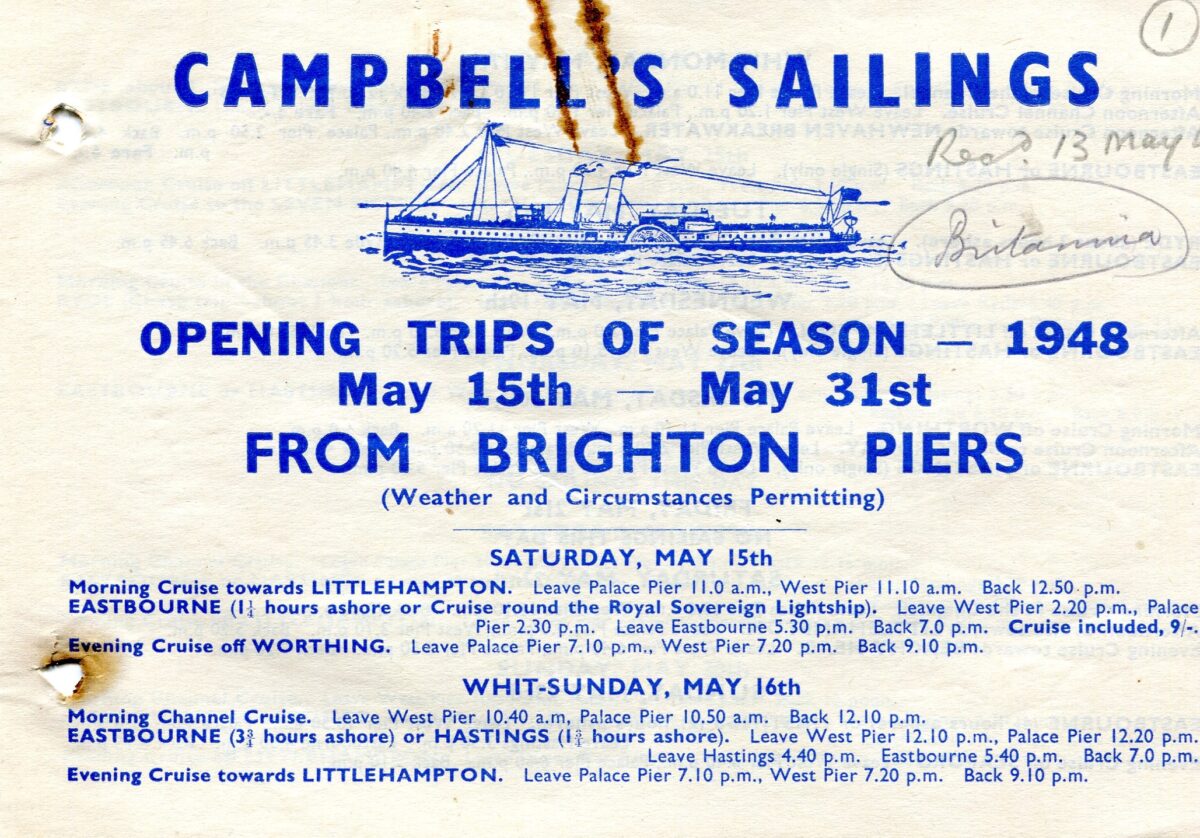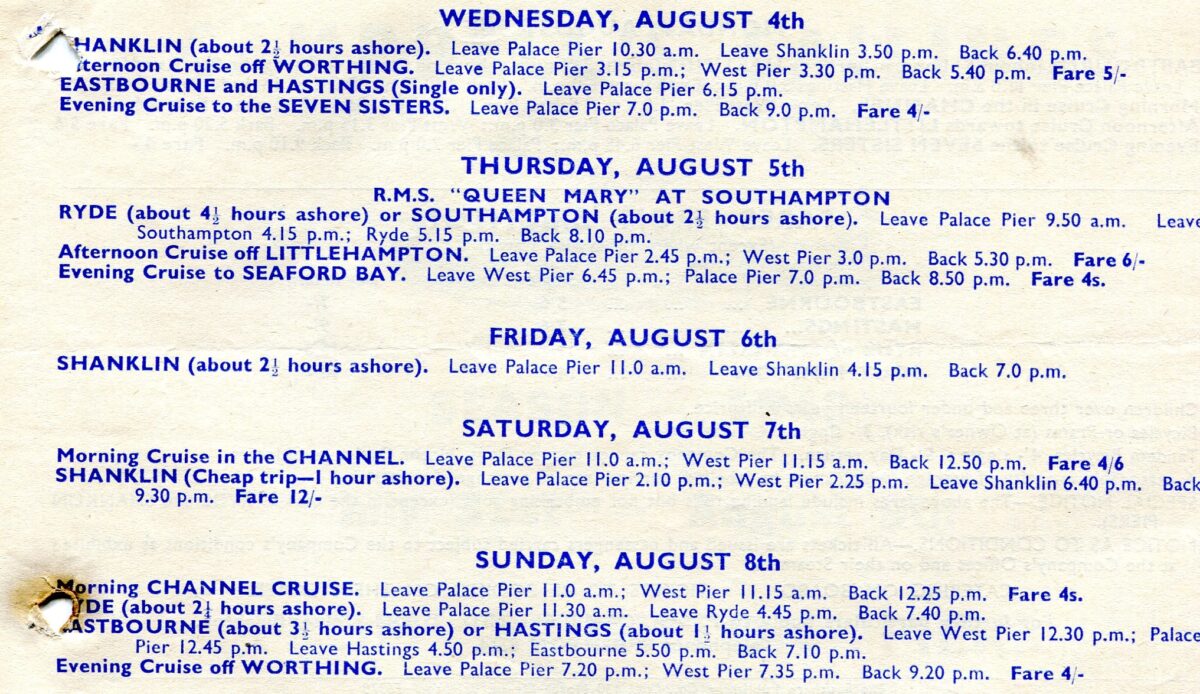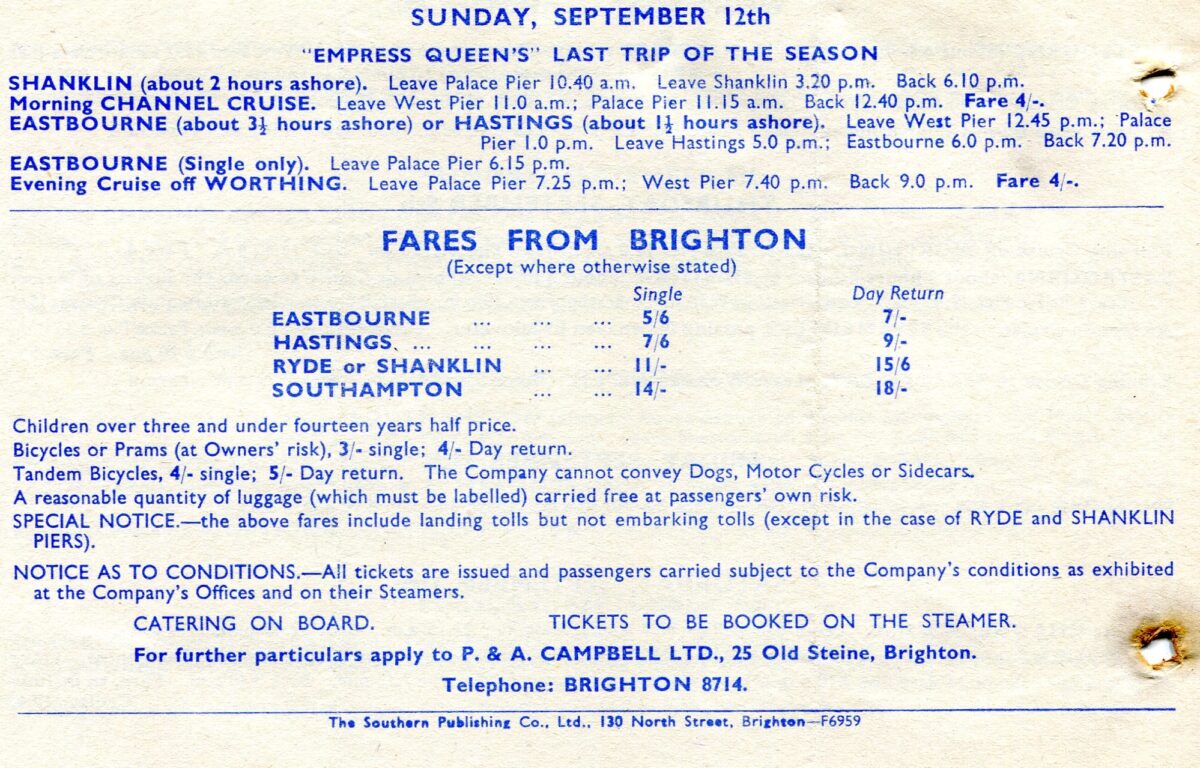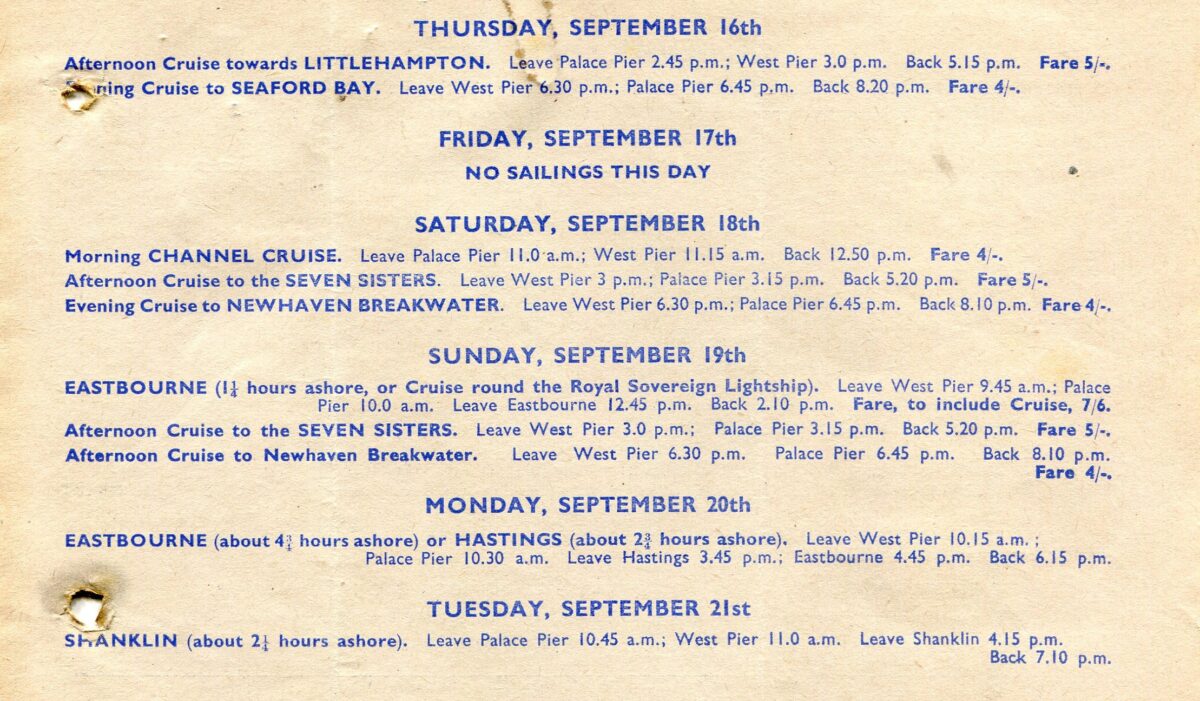Before the Second World War P & A Campbell had generally provided three, and occasionally four, paddle steamers to run their services on the Sussex Coast from the piers at Brighton, Eastbourne and Hastings. After the war they provided no service in 1946. For 1947 they fielded just one steamer at any given time with Glen Gower starting the season on Wednesday 21st May and being replaced by the large turbine steamer Empress Queen on Saturday 12th July. With the reopening of Eastbourne Pier in 1948 they decided to position two steamers in the area for the peak weeks.

First to arrive was Britannia. Once the doyen, and one time flagship of the Campbell fleet on the Bristol Channel, she arrived on the South Coast in rejuvenated form with a new oil fired boiler and now sporting two funnels rather than just one. She left Bristol on Wednesday 12th May 1948, made a call at Falmouth around midnight to take on bunkers, and arrived at Newhaven at 3.40am on Friday 14th May.

She ran her first excursions the following day, Saturday 15th May, leaving the Palace Pier at 11am and the West Pier Brighton at 11.10am for a morning cruise towards Littlehampton back 12.50pm. She then set off for Eastbourne and a cruise round the Royal Sovereign Lightship leaving the West Pier at 2.20pm and the Palace Pier at 2.30pm due back at 7pm. In the evening there was a cruise to off Worthing leaving at 7.10pm and 7.20pm from the two Brighton piers back at 9.10pm. And these were the sort of cruises which formed the backbone of her roster on through May and into June augmented by some longer day trips fitted in along the way.
For example on Tuesday 18th May she was rostered to run a day trip from Hastings, Eastbourne and both Brighton piers to Ryde, Isle of Wight, giving about two hours ashore. On Wednesday 26th May there was another day trip to Ryde this time offering just one hour ashore. Then there were further cruises to Ryde offered on 5th, 15th, 23rd June and on 1st July with an extension that day on to Southampton Docks to take a look at the Cunard liner Queen Mary. On Tuesday 8th June a trip was rostered from Eastbourne and Brighton for two and a half hours ashore at Shanklin Isle of Wight. Further trips were offered to Shanklin on 16th, 21st, 30th June and 4th July, There was an afternoon cruise to Bognor Regis on Tuesday 22nd June. And this pattern continued until the arrival of the giant Empress Queen towards the end of the second week in July.

Ordered just before the Second World War for the cross Channel trade to Boulogne from the Sussex piers, and somewhat modelled on the GSN motor ships Queen of the Channel, Royal Sovereign and Royal Daffodil built for the same trade but from the Thames piers, Empress Queen was not completed before war broke out so never ran on the service for which she had been designed. In the immediate post war years Government regulations and currency controls prevented no passport trips to France so that was that and P & A Campbell were stuck with a newish ship which was really too big to turn in a profit on any of their other services.
Empress Queen left Bristol at 7.30am on Wednesday 7th July and arrived at Newhaven at 1.15pm the following day ready to start her South Coast season on Saturday 10th July. She had a much larger bunker capacity than Britannia and did not need to call in at Falmouth along the way to top herself up with fuel.
With the two ships now based at Newhaven it might be thought that as Empress Queen was the larger of the two and was better appointed for the longer day trips then that is how she would be rostered leaving Britannia to undertake the shorter and more local trips. And to a large extent that is how the season panned out but E C B Thornton records in his excellent book “South Coast Pleasure Steamers” that it was not always the case. Empress Queen had a larger draft than Britannia and could not access some piers like Ryde at low water. Her enormous size also made her a bit of a handful on piers with a tide running across them making her prone either to being set on to land heavily or set off before the ropes could get ashore. So Britannia did undertake some of the day trips during the season leaving Empress Queen to maintain the Brighton, Eastbourne and Hastings roster.

Empress Queen’s first day trip was a monster of an offering on Sunday 11th July with a “Long Day Cruise of 125 miles Round the Isle of Wight” away from Eastbourne at 9.30am and the Palace Pier Brighton at 11am due back to Brighton by 8pm. That week there were also day trips to Shanklin on Monday 12th and Wednesday 14th and to Ryde on Tuesday 13th and Thursday 15th with the latter extending on up Southampton Water to view the Queen Mary.

And so the season carried on with one of the steamers, usually but not always Britannia, running the local trips every day and the other, usually but not always Empress Queen, taking the day trips largely to the same pattern. Each week there were at least two and sometimes three trips to Shanklin, a couple of trips to Ryde sometimes continuing on to Southampton if there was an interesting liner to look at in alongside and once a week round the Isle of Wight. Where Empress Queen had offered a couple of really long day trips to Bournemouth the previous summer, these were not advertised again in 1948.

Empress Queen’s last scheduled sailing of this season was a day trip from Eastbourne and Brighton to Shanklin on Sunday 12th September after which she returned to lay up in Bristol for the winter.

Britannia’s penultimate day in service was also a run across from Brighton to Shanklin. The following day she was rostered for her last trips of the season which included a “Morning Channel Cruise” from both of Brighton’s piers at 10.20am and 10.35 and an afternoon cruise away at 12 noon, and 12.10pm for Eastbourne (1.40pm – 5.20pm) and/or Hastings (2.40pm – 4.20pm) due back at 6.45pm. After that she was scheduled to return to Bristol to lay up
Both ships returned for a similar schedule in 1949 but after that decline was in the air. For 1950 Campbells rostered only one ship at a time for the Sussex Coast with Glen Gower starting the season in early June and being replaced by Empress Queen in early July. In 1951 Empress Queen was given a try running from Torquay, including to the Channel Islands, so there was no P & A Campbell service from Brighton, Eastbourne and Hastings that summer. In 1952 and 1953 they based Cardiff Queen in the area. For 1954, 1955 and 1956 Glen Gower returned once again to repopulate her old haunts and was able to restart at least some Cross Channel trips to Boulogne as Government regulations were gradually relaxed. However by then Campbells were in deep financial difficulty so for 1957 Glen Gower returned to run on the Bristol Channel and a service of sorts on the Sussex Coast was provided for this one year only by the smaller diesel Crested Eagle which had been taken on charter. P & A Campbell did not return to run on the Sussex Coast in 1958.
Kingswear Castle returned to service in 2023 after the first part of a major rebuild which is designed to set her up for the next 25 years running on the River Dart. The Paddle Steamer Kingswear Castle Trust is now fund raising for the second phase of the rebuild. You can read more about the rebuilds and how you can help if you can here.
John Megoran


